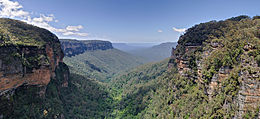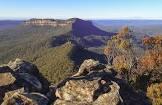The Greater Blue Mountains region consists of 1.03 million hectares of sandstone plateaus, escarpments and canyons, dominated by temperate eucalypt forests. The region, comprised of eight reserves, is renowned for its representation of the evolutionary adaptation and diversification of eucalypts during the post-Gondwanan isolation period of the Australian mainland. There are 91 species of eucalypts in the Greater Blue Mountains region, and the region is also noted for its exceptional representation of the structure and ecological diversity of eucalypts associated with a wide range of habitats. The region is an important representative of Australia's biodiversity, with 10% of vascular plants and a large number of rare or threatened species, including endemic and evolutionary relict species such as the Wollemi pine, which persist in highly restricted microsites.
| image |
http://commons.wikimedia.org/wiki/Special:FilePath/Jamison%20Valley%2C%20Blue%20Mountains%2C%20Australia%20-%20Nov%202008.jpg |
| media legend |
Jamison Valley |
| media legend |
A view over [[Jamison Valley]], in 2008. |
| start time |
2000-01-01T00:00:00Z |
| official name |
منطقة الجبال الزرقاء |
| official name |
Greater Blue Mountains Area |
| official name |
Región de las Montañas Azules |
| official name |
Région des montagnes Bleues |
| official name |
グレーター・ブルー・マウンテンズ地域 |
| official name |
Greater Blue Mountains-gebied |
| official name |
Горный район Блу-Маунтинс |
| official name |
大蓝山山脉地区 |
| volume as quantity |
World Heritage selection criterion (x) |
| area |
86200 |
| applies to part |
buffer zone |


.jpg)





